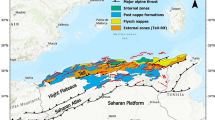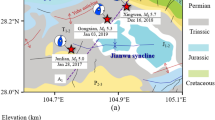Abstract
The present study aims to estimate seismicity parameters, to develop seismotectonic and isoseismal maps for the Bihar state, India. The earthquake catalog is prepared with historical and instrumental seismic events for the last 190 years (from 1833 to 2022). The completeness period for different classes of magnitude (Mw), such as 3.5 < Mw ≤ 4.5, 4.5 < Mw ≤ 5.5, 5.5 < Mw ≤ 6.5, and 6.5 < Mw ≤ 8.0, is 80 (1940–2001), 170 (1851–2022), 140 (1881–2022), and 180 (1831–2011) years, respectively. The study area's seismicity parameters a and b range from 5.13 to 5.79 and 0.64 to 0.76, respectively. The return period of major seismic events (3.5 ≤ Mw ≤ 8.5) in the Himalayan region are estimated using Gumbel’s statistical analysis along with time- and magnitude-predictable model. It is obtained that return period (Tr) of Mw ≥ 7.0 is 44 years. A seismotectonic map is developed for the 350 km radius of the influence zone from the centre of Bihar (latitude 25.8560° N and longitude 85.7868° E) by taking accounts of faults, shear zones and lineaments. Intensity-based isoseismal maps have been developed for five past major earthquakes to determine how significantly they affected the study area. It is found that a maximum Medvedev–Sponheuer–Karnik (MSK) scale intensity of X could be felt in Bihar if similar seismic events occur. The outcome of this study may be further used for the seismic hazard assessment and assessment of seismic scenario-based planning purposes of the study area.













Similar content being viewed by others
Availability of data and materials
The datasets generated during and/or analyzed during the current study are available from the corresponding author on reasonable request.
References
Abramowitz M, Stegun IA (1964) Handbook of mathematical functions. Dover, New York
Agarwal P, Shrikhande M (2006) Earthquake resistant design of structures. PHI Learning Pvt. Ltd., New Delhi
Anbazhagan P, Kumar A, Sitharam TG (2013) Ground motion prediction equation considering combined dataset of recorded and simulated ground motions. Soil Dyn Earthquake Eng 53:92–108
Anbazhagan P, Bajaj K, Patel S (2015) Seismic hazard maps and spectrum for Patna considering region-specific seismotectonic parameters. Nat Hazards 78(2):1163–1195
Anbazhagan P, Moustafa SSR, Al-Arifi NSN (2015) Seismic intensity map of South India for estimated future earthquakes. Arab J Geosci 8(11):9365–9371
Anbazhagan P, Bajaj K, Dutta N, Moustafa SSR, Al-Arifi NSN (2017) Region-specific deterministic and probabilistic seismic hazard analysis of Kanpur city. J Earth Syst Sci 126(1).
ASC (2000) Seismicity of Bihar. http://asc-india.org/seismi/seis-bihar.htm (February 12, 2023).
Baro O, Kumar A (2017) Seismic source characterization for the Shillong Plateau in Northeast India. J Seismol 21(5):1229–1249
Bose MK (2009) Precambrian mafic magmatism in the Singhbhum craton, Eastern India. J Geol Soc India 73(1):13–35
Burnwal ML, Burman A, Samui P, Maity D (2017) Deterministic strong ground motion study for the Sitamarhi area near Bihar-Nepal region. Nat Hazards 87(1):237–254
ESRI (2020) ArcGIS desktop: release 10.8. Environmental Systems Research Institute, Redlands, CA.
Gardner JK, Knopoff L (1974) Is the sequence of earthquakes in Southern California, with aftershocks removed, Poissonian? Bull Seismol Soc Am 64(5):1363
Ghosh GK, Mahajan AK (2013) Intensity attenuation relation at Chamba-Garhwal area in northwest Himalaya with epicentral distance and magnitude. J Earth Syst Sci 122(1):107–122
GSI (2000) Seismotectonic Atlas of India and Its Environs,Geological Survey of India.
Gumbel EJ (1958) Statistics of extremes. Columbia University Press
Gupta ID (2002) The state of the art in seismic hazard analysis. ISET J Earthquake Technol 39(4):311–346
Gutenberg B, Richter CF (1956) Earthquake magnitude, intensity, energy, and acceleration. Bull Seismol Soc Am 46(2):105–145
IS 1893 (2016) Criteria for Earthquake resistant design of structures,Part 1:General Provisions and buildings. Bureau of Indian Standards, New Delhi, (December), pp 1–44.
Khattri KN (1987) Great earthquakes, seismicity gaps and potential for earthquake disaster along the Himalaya plate boundary. Tectonophysics 138(1):79–92
Kijko A, Sellevoll MA (1989) Estimation of earthquake hazard parameters from incomplete data files. Part I. Utilization of extreme and complete catalogs with different threshold magnitudes. Bull Seismol Soc Am 79(3):645–654
Kolathayar S, Sitharam TG, Vipin KS (2012) Spatial variation of seismicity parameters across India and adjoining areas. Nat Hazards 60(3):1365–1379
Kramer SL (1996) Geotechnical Earthquake Engineering. Pearson Education India, Noida.
Kumar B (1992) Isoseismals of Burma-India border region earthquake of August 8, 1988. ISET J Earthquake Technol 29:57–67
Kumar A, Debnath N (2021) Seismic behaviour of a typical Rail Bridge using North-East India specific synthetic ground motions under multi-support excitation. In: Das BB et al (eds) Lecture Notes in Civil Engineering. Springer Singapore, pp 291–300
Kumar A, Anbazhagan P, Sitharam TG (2013) Seismic hazard analysis of Lucknow considering local and active seismic gaps. Nat Hazards 69(1):327–350
Kumar A, Satyannarayana R, Rajesh BG (2022) Correlation between SPT-N and shear wave velocity (Vs) and seismic site classification for Amaravati city, India. J Appl Geophys 205:104757
Mahajan AK, Kumar N, Arora BR (2006) Quick look isoseismal map of October 8 8 2005 Kashmir earthquake. Curr Sci 91(3):356–361
Mehta P, Thaker TP (2022) Seismic hazard analysis of Vadodara Region, Gujarat, India: probabilistic & deterministic approach. J Earthquake Eng 26(3):1438–1460
Menon A, Ornthammarath T, Corigliano M, Lai CG (2010) Probabilistic seismic hazard macrozonation of Tamil Nadu in Southern India. Bull Seismol Soc Am 100(3):1320–1341
Naik N, Choudhury D (2014) Development of fault and seismicity maps for the state of Goa, India. Disaster Adv 7(6):12–24
Nandy DR, Dasgupta S (1991) Seismotectonic domains of North-eastern India and adjacent areas. Phys Chem Earth 18:371–384
Nath SK, Thingbaijam KKS (2012) Probabilistic seismic hazard assessment of India. Seismol Res Lett 83(1):135–149
Nath SK, Raj A, Thingbaijam KKS, Kumar A (2009) Ground motion synthesis and seismic scenario in guwahati city—a stochastic approach. Seismol Res Lett 80(2):233–242
Nath SK, Adhikari M. Das, Maiti SK, Ghatak C (2019) Earthquake hazard potential of Indo-Gangetic Foredeep: its seismotectonism, hazard, and damage modeling for the cities of Patna, Lucknow, and Varanasi. J Seismol 23(4):725–769
NDMA (2010) Development of probabilistic seismic hazard map of India Technical Report. National Disaster Management Authority, 126.
Papazachos BC, Papaioannou CA (1993) Long-term earthquake prediction in the Aegean area based on a time and magnitude predictable model. Pure Appl Geophys PAGEOPH 140(4):593–612
Ram A, Rathor HS (1970) On frequency magnitude and energy of significant Indian earthquakes. Pure Appl Geophys PAGEOPH 79(1):26–32
Rao GNSN, Satyam DN (2022) Deterministic and probabilistic seismic hazard analysis of Tindharia, Darjeeling Sikkim Himalaya, India. J Geol Soc India 98(9):1295–1300
Ray S, Alam MJB, Haque M, Das SK, Tanmoy BB, Hasan MN (2019) A study on b-value and investigation of seismic hazard in Sylhet seismic region, Bangladesh using Gumbel’s extreme value distribution method. SN Appl Sci 1(5):1–9
Roy AB, Bhattacharya HN (2012) Tectonostratigraphic and geochronologic reappraisal constraining the growth and evolution of Singhbhum Archaean craton, Eastern India. J Geol Soc India 80(4):455–469
Satyannarayana R, Rajesh BG (2021) Seismotectonic map and seismicity parameters for Amaravati area, India. Arab J Geosci 14(22).
Sinha SK, Gupta SD (2020) Missing Coal Seam between East and West Bokaro near Lugu Hill of Damodar Basin, India: a geological model. J Geol Soc India 96(3):298–307
Sinha R, Sarkar R (2020) Seismic hazard assessment of Dhanbad City, India, by deterministic approach. Nat Hazards 103(2):1857–1880
Sinha R, Sarkar R (2020) Probabilistic seismic hazard assessment of Dhanbad City, India. Springer, Bulletin of Engineering Geology and the Environment
Sitharam TG, Sil A (2014) Comprehensive seismic hazard assessment of Tripura and Mizoram states. J Earth Syst Sci 123(4):837–857
Sitharam TG, Anbazhagan P, Ganesha Raj K (2006) Use of remote sensing and seismotectonic parameters for seismic hazard analysis of Bangalore. Nat Hazards Earth Syst Sci 6(6):927–939
Sitharam TG, James N, Vipin KS, Ganesha Raj K (2012) A study on seismicity and seismic hazard for Karnataka State. J Earth Syst Sci 121(2):475–490
Sreejaya KP, Raghukanth STG, Gupta ID, Murty CVR, Srinagesh D (2022) Seismic hazard map of India and neighbouring regions. Soil Dyn Earthquake Eng 163(August):107505
Srivastava RK, Sinha AK, Kumar S (2012) Geochemical characteristics of Mesoproterozoic metabasite dykes from the Chhotanagpur Gneissic Terrain, eastern India: Implications for their emplacement in a plate margin tectonic environment. J Earth Syst Sci 121(2):509–523
Srivastava VK, Adwani A, Saxena A, Arora Y (2014) A note on probability of occurrence of largest earthquake in Jharkhand State (India) and nearby region based on Gumbel’s extreme value theory. Univers J Geosci 2(6):180–185
Stepp JC (1972) Analysis of completeness of the earthquake sample in the Puget Sound area and its effect on statistical estimates of earthquake hazard. In: Proceedings of the 1st international conference on Microzonazion, 2(1), 897–910
Szeliga W, Hough S, Martin S, Bilham R (2010) Intensity, magnitude, location, and attenuation in India for felt earthquakes since 1762. Bull Seismol Soc Am 100(2):570–584
Thaker TP, Rathod GW, Rao KS, Gupta KK (2012) Use of seismotectonic information for the seismic hazard analysis for Surat city, Gujarat, India: deterministic and probabilistic approach. Pure Appl Geophys 169(1–2):37–54
Thingbaijam KKS, Nath SK, Yadav A, Raj A, Walling MY, Mohanty WK (2008) Recent seismicity in Northeast India and its adjoining region. J Seismol 12(1):107–123
Tinti S, Mulargia F (1985) An improved method for the analysis of the completeness of a seismic catalogue. Lettere Al Nuovo Cimento 42(1):21–27
Uhrhammer R (1986) Characteristics of northern and central California seismicity. Earthquake Notes, (57.1), 21
Wells DL, Coppersmith KJ (1994) New empirical relationships among magnitude, rupture length, rupture width, rupture area, and surface displacement. Bull Seismol Soc Am 84(4):974–1002
Wiemer S (2001) A software package to analyze seismicity: ZMAP. Seismol Res Lett 72(3):373–382
Wiemer S, Wyss M (2000) Minimum magnitude of completeness in earthquake catalogs: examples from Alaska, the Western United States, and Japan. Bull Seismol Soc Am 90(4):859–869
Zafarani H, Ghafoori SMM (2013) Probabilistic assessment of strong earthquake recurrence in the Iranian Plateau. J Earthquake Eng 17(3):449–467
Zafarani H, Ghafoori SMM, Adlparvar MR, Rajaeian P, Hasankhani A (2015) Application of time- and magnitude-predictable model for long-term earthquake prediction in Iran. Natural Haz 78(1):155–178
Acknowledgements
Authors thank the two anonymous reviewers whose suggestions helped improve and clarify this manuscript.
Funding
Both authors’ fellowships granted by the Ministry of Education (MoE), Government of India (New Delhi) allowed the present study to be conducted. Their support is gratefully acknowledged.
Author information
Authors and Affiliations
Contributions
AK—Conceptualization, Methodology, Software, Writing—original draft. SD: Visualization, Data curation, Validation, Writing—review & editing. All authors reviewed the manuscript.
Corresponding author
Ethics declarations
Conflict of interest
The authors declare that they have no known competing financial interests or personal relationships that could have appeared to influence the work reported in this paper.
Ethical approval
Not applicable.
Rights and permissions
Springer Nature or its licensor (e.g. a society or other partner) holds exclusive rights to this article under a publishing agreement with the author(s) or other rightsholder(s); author self-archiving of the accepted manuscript version of this article is solely governed by the terms of such publishing agreement and applicable law.
About this article
Cite this article
Kumar, A., Das, S. Estimation of Seismicity Parameters and Development of Seismotectonic and Isoseismal Maps for Bihar, India. Iran J Sci Technol Trans Civ Eng (2023). https://doi.org/10.1007/s40996-023-01243-2
Received:
Accepted:
Published:
DOI: https://doi.org/10.1007/s40996-023-01243-2




